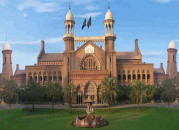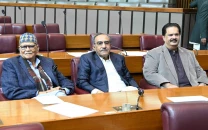Circular debt in gas sector frozen
Interim minister says step taken in wake of its price hike

Caretaker Energy Minister Muhammad Ali on Thursday announced that the government had frozen circular debt in the gas sector in the wake of the recent hike in its prices.
The current circular debt in the entire energy sector stands at Rs4.5 trillion without interest payments.
In terms of gas, the existing circular debt is Rs2.1 trillion and Rs2.3 trillion in the power sector.
The interim minister said the government had already stopped the addition of circular debt in the power sector following a commitment with the International Monetary Fund (IMF).
He added that there would be no new addition in the circular debt in the gas sector after recent increase in its prices.
Responding to a question, he said the cost of the circular debt in the power sector was Rs400 billion because of bank borrowings.
However, there was a nominal cost of circular debt in the gas sector as the bank borrowings were not involved.
The caretaker energy minister explained that there had been no change in the prices of gas supplies during the whole first half of fiscal year 2022-23.
He added that the second half prices were only increased point forward and did not cover for the required regassified liquefied natural gas (RLNG) diverted towards the domestic segment in winters.
He maintained that a circular debt of Rs461 billion was created only in FY23 because of these reasons. He added that the gas price hike effective from January 2023 was the first increase in the last 2.5 years.
Ali said in case the caretaker government did not proceed to increase the prices as per the Oil and Gas Regulatory Authority’s (Ogra) advice, there would be a further addition in the circular debt of around Rs400 billion.
The gas sector is on the verge of collapsing as many exploration and production have exited the country because of the sovereign and provincial risks.
This is further aggravated by inability of the federal government to fund exploration or import gas.
“[As many as] 57% of the domestic gas connections fall in the protected category, where there is no increase in the price,” the minister said, adding that a predetermined; bill of Rs400 per month was being introduced on account of fixed charges that was a “negligible” amount.
He continued that the country could not afford to give a scarce resource on giveaway prices.
Ali said it was still ensured that the monthly bill of the protected class did not exceed Rs900 on a consumption of 0.9 cubic hectometers (Hm3) in a month.
After the increase in the fixed charges of Rs10 to Rs400 per month for domestic consumers, there will be a maximum bill of Rs1,300 per month.
The government has completely kept the sale price for gas supplies to tandoors unchanged because roti is a prime and foremost necessity.
Only 30% households of Pakistan are availing piped gas.
The minister noted that piped gas was an urban phenomenon and only available in cities and towns.
He added that the remaining population of the country was either using liquefied petroleum gas (LPG) in cities and town and biomass, wood and cow dung in rural areas with some exceptions.
Gas consumption of 0.9 Hm3 is equivalent to 6 LPG cylinders (1 Hm3 = 3.5 metric million British thermal unit [mmbtu] and 1 domestic LPG cylinder = 0.55 Hm3) which cumulatively costs around Rs18,000.
Industry tariffs are set so as to rationalise the gas prices in the North and South regions.
Currently the North region is ring fenced for RLNG supplies and paying its full prices.
In comparison with this, the industry in South is availing natural gas at Rs1,100 per mmbtu for export consumers and Rs1,200 per mmbtu for non-export ones.
The interim energy minister said the recent increase in gas prices would not increase the revolving debt of the petroleum sector.
"Now there will be no losses in the gas sector," he added.
"International gas companies will not leave the country because of the circular debt of gas.”
Ali also highlighted an initiative aimed at boosting the country's gas production.
He added that the petroleum division was also working on a marginal policy in a bid to boost the production of indigenous gas.
The caretaker energy minister said the government had brought the tariff of the highest gas consumer at par with LPG, indicating an effort to standardise pricing across different consumer categories.
He said 57% of the domestic consumers used 31% of the total gas in the country.
"In order not to burden the farmers, the gas price for the fertiliser sector has not been increased,” he added.
With winter on the horizon, Ali said during the season, gas would be expensive and only available for eight hours.
"Gas will be available in the morning, afternoon, and evening during the meal hours," outlining a schedule to ensure that essential needs were met.
He added that gas consumers would have to shift to LPG in the next coming years because of the shortage of the natural resource.
The minister also announced maintaining the ban on new gas connections.
"There is no gas in the country for new connections,” he explained.
In an effort to address the looming energy crisis, the minister said two liquefied natural gas (LNG) cargoes had been arranged for December to minimise its effects in the winter season.
He added that the government would also order 2 LNG cargoes for January as well.



















COMMENTS
Comments are moderated and generally will be posted if they are on-topic and not abusive.
For more information, please see our Comments FAQ